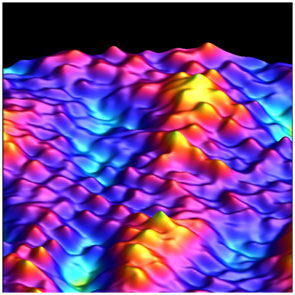| Mar 28, 2011 |
First images of oxygen atoms and their motion in material for energy and information technologies
|
|
(Nanowerk News) Manganese oxides, or manganites, are technologically important materials, used widely as solid oxide fuel cell cathodes. They have also been shown to exhibit electroresistance, a property which may be exploited to create resistive memory cells, or "memristors". Oxygen bulk diffusion and surface exchange processes are crucial processes for both catalytic action and electroresistance: to better understand these processes, it is desirable to be able to image individual surface oxygen defects.
|
 |
| A scanning tunnelling microscope image of the layered manganite PrSr2Mn2O7. The small, regular corrugation corresponds to the atomic lattice: the larger, underlying modulations are associated with chemical inhomogeneities in this model material for fuel cell cathodes.
|
|
In a recent paper ("Imaging oxygen defects and their motion at a manganite surface"), researchers at the London Centre for Nanotechnology, in collaboration with the University of Geneva, Japan Science and Technology Agency and the University of Tokyo, have shown the first atomic resolution images of oxygen defects at a manganite surface, using ultra-high vacuum scanning tunnelling microscopy.
|
|
This experiment revealed an atomically flat surface for the layered manganite PrSr2Mn2O7, and also a surface with defects, identified as oxygen adatoms and vacancies. Defect dynamics, including oxygen adatom migration, vacancy-adatom recombination and adatom bistability, were observed using time-resolved scanning tunnelling microscopy and spectroscopy. These data provide an experimental basis for testing models of oxygen migration at transition-metal oxide interfaces, and thereby suggest future strategies for optimizing catalytic reactions at manganite surfaces.
|

